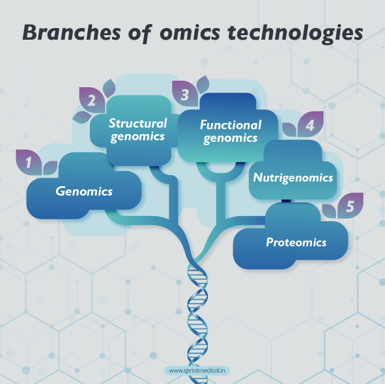Omics technology in dermatology
Introduction:
- The term omics refers to a branch of biology that ends in -omics, such as genomics, transcriptomics, proteomics, or metabolomics.
- The suffix -ome denotes the objects of study in various realms, such as the genome, proteome, transcriptome, or metabolome. More specifically, genomics is the science that studies the structure, function, evolution, and mapping of genomes in order to characterize and quantify genes, which control protein creation via enzymes and messenger molecules.
- The overall goal of omics research is to identify, characterize, and quantify all biological molecules involved in the structure, function, and dynamics of a cell, tissue, or organism.

Figure 1: Different branches of omics technology
Types of omics technology:
1. Genomics
- The science of constructing genome maps of all genes in various organisms, identifying genome sequences, and conducting research and analysis on genome expression and function is referred to as genomics.
- DNA chips, all exon capture sequencing technologies, and quantitative analysis technologies such as qRT-PCR are examples of common genomics technology. Genome-wide Association Study (GWAS), Serial Analysis of Gene Expression (SAGE), and CRISPR/Cas technologies are also included.
- While the advantages of genomics are high throughput and high accuracy, the disadvantages are its high cost and long sequencing time.
- The possible applications of Genomics include skin cancer research, dandruff treatment, and diagnosis and treatment of Genetic skin disorders.
2. Transcriptomics
- Transcriptomics research methodologies are classified into two kinds. One is hybridization-based, such as gene chip technology. The other category is transcriptomics technology based on sequencing technology, which includes expressed sequence tags (EST), serial analysis of gene expression (SAGE), massively parallel signature sequencing (MPSS), and RNA sequencing technology (RNA-seq).
- The advantages of transcriptomics include high sensitivity, repeatability and high detection range. However, the disadvantages include high processing costs and challenges in information processing.
- The possible applications of transcriptomics include understanding the mechanism and therapeutic targets of psoriasis, studying sun damage and aging for prevention and management, and identifying the pathways for skin cancer.
3. Proteomics
Proteomics refers to all proteins expressed in the whole genome of a specific cell or living forms. Proteomics seeks to understand the composition, functional mode and interactions of all proteins in a cell, tissue, and body fluid. Although genes play an influential role in protein synthesis,, the level of gene expression does not represent the level of active protein in the cell
According to different research purposes and methods, proteomics can be divided into:
- Expression proteomics, which is the quantitative study of the whole proteome or sub proteome of cells, tissues and organs,
- Structural proteomics, which aims to map the structure of protein complexes or proteins present in specific organelles, and
- Functional proteomics refers to a number of specific, instructive proteomic methods that study and characterize a selected group of proteins and provide important information about protein signaling, disease mechanisms, or protein-drug interactions
Examples of research in the field of proteomics are two-dimensional gel electrophoresis, mass spectrometry, two-dimensional capillary electrophoresis and yeast two-hybrid system.
4. Metabolomics
Metabolomics is a new branch of systems biology emerging after genomics, transcriptomics, and proteomics. It is a study of all metabolic responses of living individuals to stimuli, environmental changes, or genetic modifications of exogenous substances (drugs or poisons). It detects the full picture of this response as well as its dynamic changes.
Compared with transcriptomics and proteomics, metabolomics has the following advantages :
- Effective and small changes in gene and protein expression are amplified on metabolites, making detection easier.
- Metabolomics does not require whole-genome sequencing and gene database construction.
- Metabolomics can use body fluids such as sweat and blood as substrates, which makes sampling more convenient.
- The types and quantities of metabolites are far smaller than genes and proteins.
5. Lipidomics
Lipidomics is the comprehensive and systematic analysis of lipids in organisms, tissues or cells and the molecules that interact with them, understanding the structure and function of lipids, and then revealing the relationship between lipid metabolism and the physiological and pathological processes of cells, organs and even the body.
Lipidomics can be regarded as an independent subject for its unique properties and functions. At present, the study of lipidomics is mainly concentrated in the:
- Identify the structure and type of new lipids;
- Network analysis to elucidate metabolism in healthy and ill patients, biomarker analysis of disease status;
- High-throughput processing and molecular modeling by using lipid omics data;
- Develop quantitative methods to analyze low-level lipids in organisms [1].
Disadvantages
- Long sequencing time and high cost
- Requires many samples, and information processing is cumbersome.
- Insufficient sensitivity to detect and quantify low-abundance proteins
- Metabolites change rapidly, stability is difficult to control, and false positives may occur
- There are many types of lipids, complex structures, and high requirements for related detection techniques; absolute quantification of some lipids is difficult to achieve
- The data are huge, and it is difficult to collect, store, develop, and utilize [2].
Advantages
- Microcosmic, high throughput, high accuracy
- Good repeatability, high sensitivity, and wide detection range.
- Qualitative and quantitative detection of different proteins.
- The detection is easier, the sampling is convenient, and the type and quantity are far smaller than genes and proteins.
- High-quality accuracy, high coverage, and low sample consumption.





